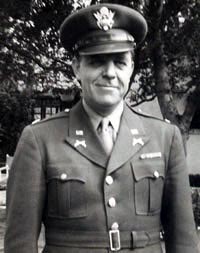Byington Ford
Byington Ford | |
|---|---|
 Lieutenant Byington Ford, ca. 1942 | |
| Personal details | |
| Born | Lewis Byington Ford November 1, 1890 Downieville, California, U.S. |
| Died | January 19, 1985 (aged 94) Ventura, California, U.S. |
| Spouse(s) | Marion Boisot Ruth Arlen |
| Children | Mary Jane Ford Patricia Reid Ford Audrey Ford |
| Parent(s) | Tirey L. Ford Mary Emma Byington |
| Occupation | Carmel Valley Developer |
| Known for | Developed the Carmel Valley Airport and Carmel Valley Village |
| Military service | |
| Allegiance | |
| Branch/service | United States Air Force |
| Years of service | 1917–1919 1942-1943 |
| Rank | Captain (armed forces) 1917 Lieutenant colonel (US) 1942 |
| Commands | 26th Infantry Division (United States) |
| Battles/wars | Meuse-Argonne Campaign |
Lewis Byington Ford (November 1, 1890 - January 19, 1985) was born in Downieville, Sierra County, California, the son of Attorney-General Tirey L. Ford and Mary Emma Byington. Byington Ford was a prominent Monterey Peninsula real estate developer.
Early life
Ford graduated from Santa Clara College in 1910 and the University of California at Berkeley in 1912, where he earned his degree of Master of Arts.[1]
In 1916, Ford was Director of the Animated Film Corp in San Francisco, of which his father, Tirey L. Ford, was president. The company produced animated cartoons long before Walt Disney. Ford worked with Benjamin Thackston Knight (1895–1977), aka "Tack" Knight, Pinto Colvig and Angel Espoy. The endeavor ended with the entry of the U.S. into World War I.
In 1917, Ford enlisted in the California National Guard and went to Officers Training Camp at the Presidio of San Francisco where he was commissioned and then sent to France during World War I. He was Captain in the 26th "Yankee" Division. In France, he trained at the Saint-Cyr cavalry school.[2] He was in the engagements of Château-Thierry, St. Mihiel and the Toul sector. On March 10, 1919, Ford returned home after recuperating from a poison gas attack suffered during an advance in Troyon, France. Ford saw active service practically the whole time he was in France. He brought a detachment of soldiers to New York from France.[3]
In 1919, working with Samuel Finley Brown Morse, Ford became manager at the Del Monte Properties in Pebble Beach, California, heading their real estate department for twelve years. He rode horseback through the undeveloped parts of Del Monte Forest to survey the land for development.
On November 17, 1920, Ford married Marion Boisot in Pebble Beach. In 1922, he built their home on 17-Mile Drive in Pebble Beach, which faced the first green of the golf course, and was constructed by Bernard Maybeck. In 1931 he formed the Carmel Realty Company.[4] He and his wife Marion had three children, Mary Jane, Patricia, and Audrey.
Later life
Ford was active for years as a player and coach in the Peninsula's old Abalone League with other pioneers such as Samuel F.B. Morse and author Jimmy Hopper. In 1928, to raise money for a league diamond, Ford staged plays at the Carmel Arts and Crafts Theater, recognized today as The Golden Bough Playhouse. He was the leading man in the play "The Copperhead" at the Carmel playhouse. He acted in, directed, and wrote more than 45 plays at the Carmel Arts and Crafts Theater.
Ford developed the first airpark in Carmel Valley. According to the Carmel Valley Historic Airport Society, "Convinced that mass production of small aircraft would put a plane within the reach of anyone who could afford a car, in the late 1930's Byington bought the northeast corner of Rancho Los Laureles for an airpark. He and his brother Tirey Ford developed the Carmel Valley Airport for pilot-owners who would want to be at home a minute or two after getting out of their plane."[5] A nearby road was named after him called Ford Road.[6] Ford constructed the first two "hangar homes" when he opened the air park to the public on December 7, 1941. His timing that proved unfortunate as this was the same day Pearl Harbor was bombed.[7]
In 1941, he enlisted in the Air force during World War II and became a Lieutenant colonel (United States). Ford established the 1st women's MP at the Wright-Patterson Air Force Base, Dayton, Ohio.
In 1946, Byington and his brother, Tirey Ford, developed the Carmel Valley Village and Airway Market, first known as the General Store, a barber shop, a drug store and soda fountain, a beauty shop, and a liquor store. All were in walking distance of the Airpark and decorated to resemble a Mexican village. The village is about 12 miles from the mouth of Carmel Valley Village, California.[8]
In 1955, he wrote a sketch book called "A Cartoon Sketch Book for Beginners."[9]
Death
On January 19, 1985, at age 94, Ford died of pancreatic cancer at his home in Ventura, California.[10]
References
- ^ University of California Register, Berkeley, 1912-13, University of California Press Berkeley, 1913.
- ^ World War I Draft Registration Cards, 1917-1918
- ^ San Francisco Chronicle; "Captain Byington Ford, Son of Tirey L. Ford, Among Men to Arrive"
- ^ Selected Letters of Langston Hughes: Edited by Arnold Rampersad and David Roessel
- ^ Carmel Valley Historical Society.,
- ^ Carmel Valley Air Park, Carmel Magazine, 2014
- ^ Living at Runway's Edge, LA Times, 2001.
- ^ Monterey County California Regional Guide
- ^ Sketch Book by Byington Ford, 1955
- ^ California Death Index and Social Security Death Index.
